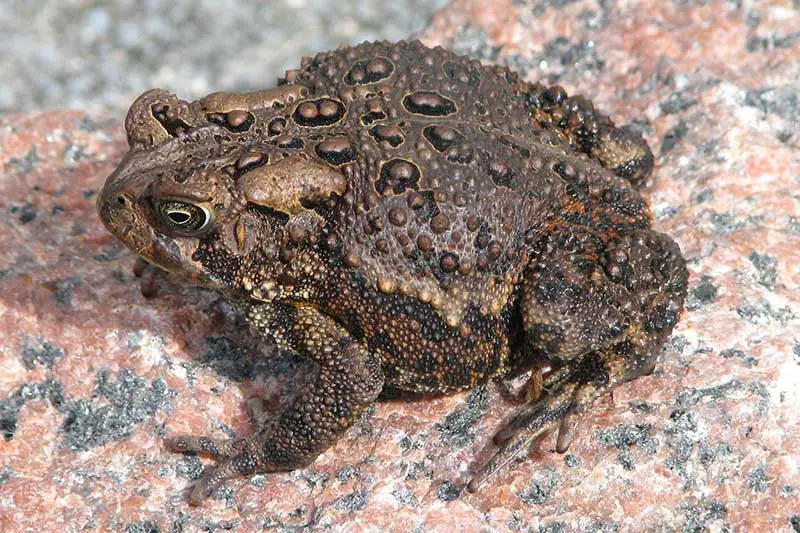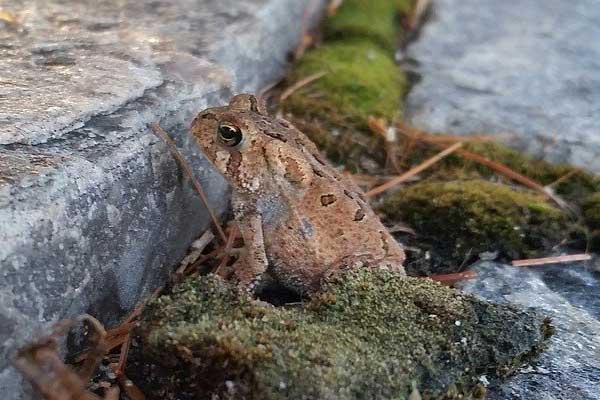Toads live throughout North America. You can actually find toads on every continent worldwide, except Antarctica. However, there are only two species of toads in Michigan. Both are in the Family Bufonidae and are known as true toads.
The 11,037 inland lakes, 300 rivers, and 3,288 miles of freshwater shoreline in Michigan provide a great environment for toads to reproduce. Although all toads start as tadpoles living in water, not all species enjoy the water once they are adult toads. Generally, you can find Michigan toads in open landscapes, sandy areas, or suburban locations.
Although both toads and frogs are part of the Anura order, they are very different. Toads differ in various ways, including their skin type, sounds, and distinctive warts. Let’s learn more about the 2 types of toads in Michigan.
Toads in Michigan
The 2 species of toads in Michigan are the Eastern American toad and Fowler’s toad.
1. Eastern American Toad

Scientific name: Bufo americanus
The Eastern American Toad color ranges from red-brown, brown, or tan to gray or olive. Their underside is pale, with dark spots on the chest. They also have a grayish skin flap on their throat, which is their vocal pouch. Adults can grow up to 4.4 inches in length.
These toads enjoy the land and will only be in the water temporarily while breeding and laying eggs. They are also nocturnal and prefer warm and humid weather. You can find Eastern American toads throughout Michigan. Often in the forest edges, meadows, marshes, open woodlands, agricultural land, and suburban areas.
Eastern American toads eat various small invertebrates, such as mealworms, earthworms, spiders, slugs, ants, moths, and centipedes. They are also known to live over 30 years. Females lay thousands of eggs in two separate strings. The eggs hatch into tadpoles after 3 to 12 days and become juvenile toads after 50 to 65 days.
2. Fowler’s Toad

Scientific name: Bufo fowleri or Anaxyrus fowleri
Fowler’s toads are olive green, gray, brown, and rust red with darkened warts. Their bellies are usually whitish with an occasional dark spot. As they age, a pale stripe will develop down their back. They can grow up to 3.7 inches in length as adults. Fowler’s toads reproduce in May and June. Females will have between 7,000 to 10,000 eggs that hatch within a week later.
This toad prefers sandy areas, especially by rivers and shorelines. They can be found in the southern lower peninsula and far western areas of Michigan. They hunt at night and live underground during the day to prevent water loss.
If you’re curious about what Fowler toads eat, their diet mainly consists of insects and small invertebrates, contributing to their role in the ecosystem as effective predators.
Fowler’s toads are sometimes mistaken for American toads. However, the Fowler toad takes short, quick hops and has a loud, high-pitched, and long “waaaaaaaa” call. This call sounds like a herd of sheep.
FAQs About Toads
1. How Are Toads Different from Frogs?
The main difference between toads and frogs is that toads have dry skin with warts. They also have crests behind their eyes and short hind legs. Unlike frogs, toads can puff up their bodies to look bigger when they see predators. Toads also lay their eggs in chains, but frogs lay them in clusters.
2. Are Toads Poisonous?
Yes, they are. Toads have parotid glands that secrete poison to help defend themselves. The secreted poison is called a bufotoxin that can kill small animals and cause allergic reactions to humans, including burning eyes and irritated skin. It is generally not harmful to common house pets but could cause an allergic reaction. The bufotoxin usually looks like a white, milky substance.
3. What Do Toads Eat?
Most toads eat insects and small invertebrates. However, Fowler’s toads will not eat earthworms. A standard-sized toad can eat around 3,200 insects per season, making them great for garden pest control. When they are tadpoles, they are herbivores and eat soft plant material or algae.
4. What Predators Eat Toads?
Common predators of toads are raccoons, snapping turtles, snakes, and birds of prey. Toads sometimes secrete poison, puff up, or play dead to avoid these predators.
5. Are Michigan Toads Endangered?
The Michigan Department of Natural Resources lists the Fowler’s toad as a species of special concern. The Eastern American toad is found more commonly throughout Michigan. Although not endangered, there have been recent declines in the population in the Great Lakes area.
6. Do Michigan Toads Make Sounds?
Both species of toads in Michigan have distinct sounds. The Fowler’s toad has a nasal “waa” sound. It makes a low-pitched bleat that sounds like a herd of sheep. In contrast, the Eastern American Toad’s sound is more musical and prolonged, lasting up to 30 seconds. Male toads will make sounds to attract females or keep other males from their territory.
7. Can You Get Warts From Toads?
No, you cannot. Warts are caused by a virus that can only be transferred to humans from another human, not from toads. However, it would be best if you always washed your hands after handling a toad due to the bufotoxin.
8. Can Toads Swim?
Yes, toads can swim, even though the water is usually puddles or shallow streams. Toads are dependent on water, especially to reproduce and lay eggs. However, toads can survive longer without water compared to other frogs. This is why you can find toads further away from bodies of water.
9. Do Toads Hibernate?
Not exactly. Toads brumate during the winter months to conserve energy. Brumation is similar to hibernation, but what cold-blooded animals do. To brumate, toads will burrow into the ground, under leaves, or logs. The Eastern American toad is known to keep burrowing deeper into the ground as days get colder.
10. Can Chemicals Kill Toads?
Yes, they can! Toads are thin-skinned and can easily be harmed or killed by chemicals in everyday products harmless to us. Examples include soap, sunscreen, and insect repellents. So, make sure not to handle a toad if you have these on your hands.




